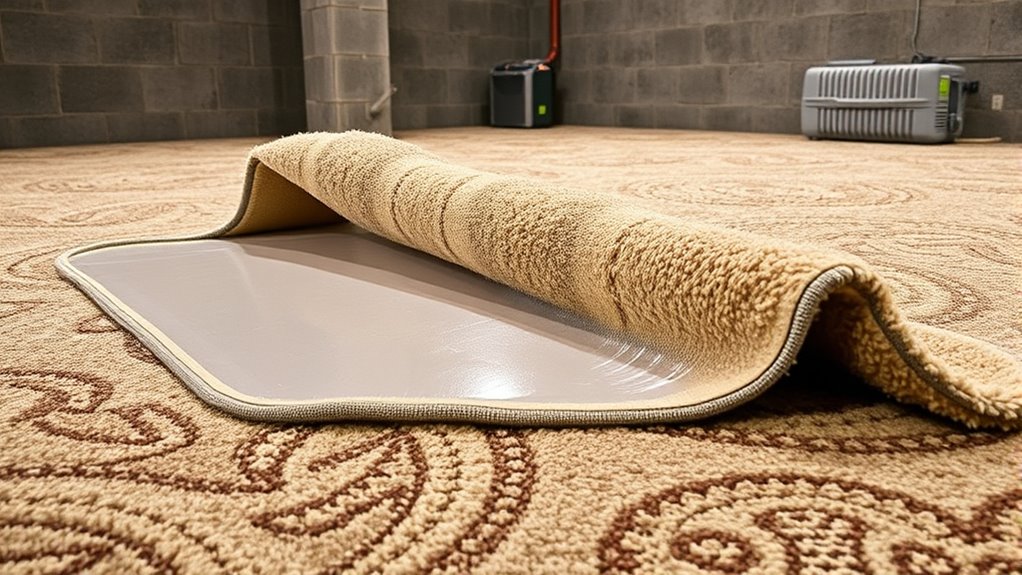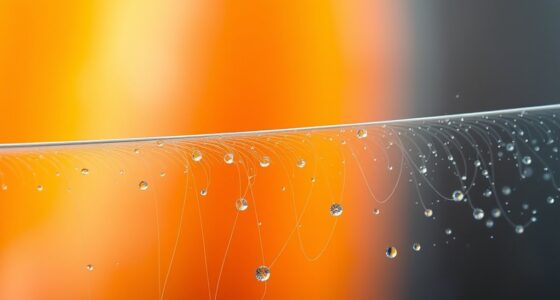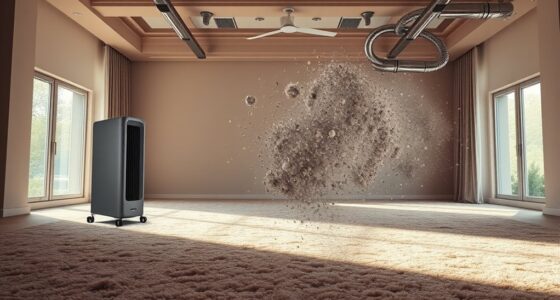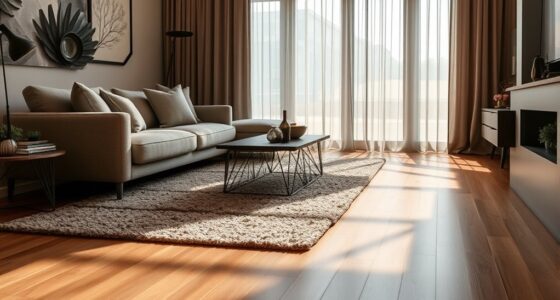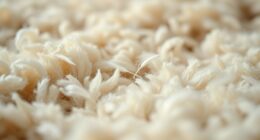To protect your basement rugs from moisture, install a reliable moisture barrier like polyethylene sheets or liquid membranes on the floor. Make sure the barrier is properly laid out, overlapping seams by at least six inches and securing edges tightly to prevent water from seeping through. Regular inspections and prompt repairs keep the barrier effective over time. Keep going to find out more tips to safeguard your rugs and maintain a dry basement environment.
Key Takeaways
- Install a moisture barrier beneath rugs to prevent ground moisture from seeping into basement flooring.
- Use polyethylene sheets or liquid membranes to create an effective waterproof layer.
- Ensure proper overlapping and sealing of seams for maximum protection against water infiltration.
- Regularly inspect and maintain the barrier to identify and repair tears or damage promptly.
- Maintaining a moisture barrier extends rug lifespan and improves overall basement air quality.
Understanding the Role of Moisture Barriers in Basement Environments

Moisture barriers are essential components in basement environments because they prevent ground moisture from seeping into your space. When moisture penetrates, it can cause mold, mildew, and structural damage. By installing a moisture barrier, you create a protective layer that blocks water from reaching your basement surfaces. This barrier helps maintain a dry environment, reducing the risk of musty odors and damage to flooring or walls. It also plays a crucial role in controlling humidity levels, which can otherwise lead to condensation and dampness. Without a proper moisture barrier, your basement remains vulnerable to water intrusion, compromising both your belongings and the integrity of the foundation. In short, moisture barriers are a key defense against the persistent challenge of ground moisture in basement spaces.
Types of Moisture Barriers and Their Features
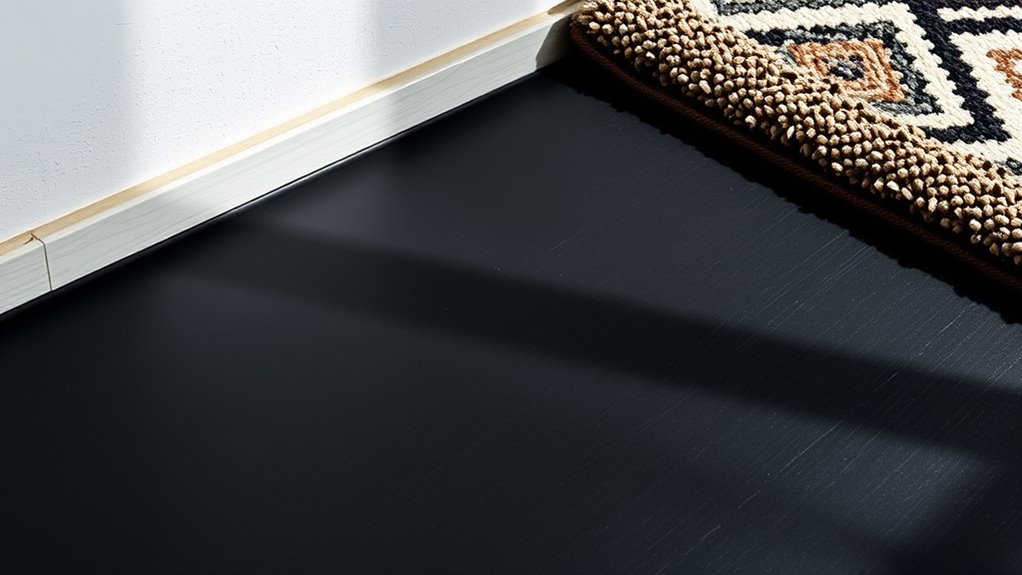
There are several types of moisture barriers available, each designed to suit different basement conditions and needs. Choosing the right one depends on factors like moisture levels, soil type, and your budget.
- Polyethylene Sheets: Affordable and easy to install, these are the most common barriers. They come in various thicknesses for different levels of protection.
- Liquid Membranes: Applied as a coating, these create a seamless, waterproof layer that’s ideal for irregular surfaces.
- Vapor Barriers: Typically made of plastic or foil, they prevent moisture vapor from passing through walls and floors.
- Composite Barriers: Combining materials like foil and foam, these offer insulation along with moisture protection, perfect for colder basements.
- Installation Considerations: Proper installation of moisture barriers is crucial to ensure effectiveness and prevent issues like mold or structural damage. Proper installation procedures help maximize the lifespan and performance of your chosen barrier.
Understanding these options helps you select the best barrier to keep your rugs dry and mold-free.
Proper Installation Techniques for Optimal Protection
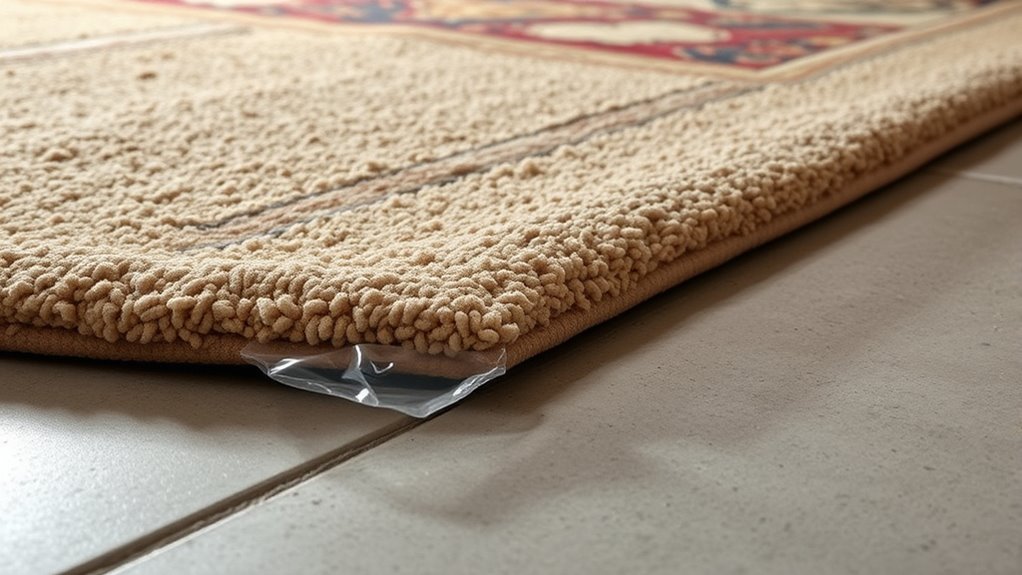
To guarantee your moisture barrier provides maximum protection, proper installation is essential. Start by preparing the surface, ensuring it’s clean, dry, and free of debris. Roll out the barrier flat, avoiding wrinkles or folds that can trap moisture. Secure the edges with compatible tape or fasteners, making sure they adhere well and create a tight seal. Overlap seams by at least 6 inches, sealing them thoroughly to prevent any gaps. Pay close attention to corners and edges, ensuring they are properly tucked and sealed. Avoid puncturing or damaging the barrier during installation, as small tears can compromise its effectiveness. Additionally, selecting a moisture barrier material with a high contrast ratio can help reflect light better and improve the overall visual environment. Finally, double-check all seams and edges before placing your rug to ensure the barrier is secure and continuous for maximum moisture protection.
Benefits of Using Moisture Barriers for Your Rugs
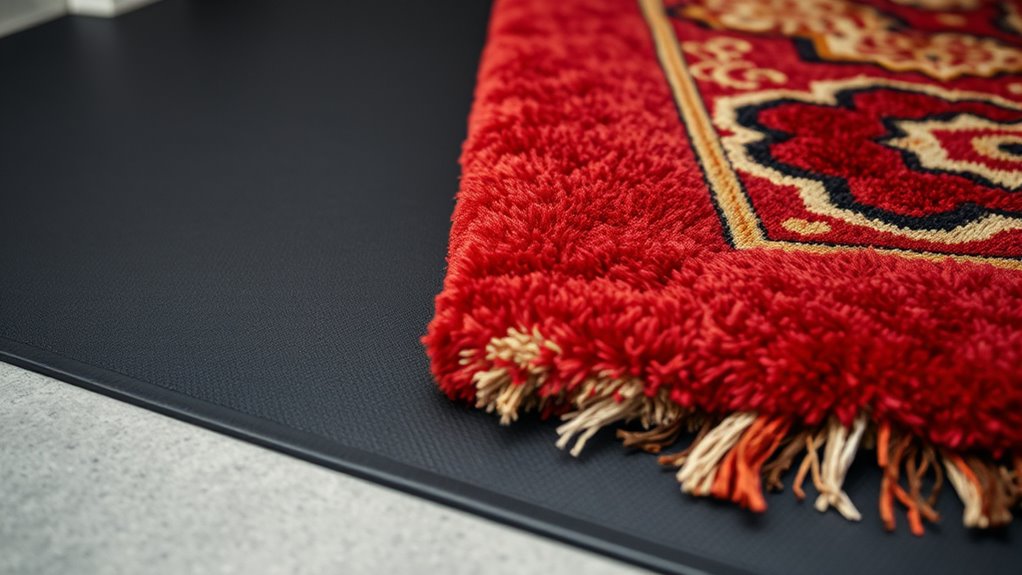
Using a moisture barrier under your rugs offers essential protection against hidden water damage and mold growth. It acts as a shield, preventing moisture from seeping into your flooring and causing long-term harm. This barrier helps maintain a dry environment, which is vital in basements prone to humidity. It also extends the life of your rugs by reducing exposure to moisture that can lead to rot or mildew. Additionally, moisture barriers improve indoor air quality by minimizing mold spores and dampness. They’re easy to install and cost-effective, providing peace of mind without significant expense. Incorporating AI safety measures can further enhance the reliability of moisture barriers by ensuring consistent performance and detecting potential failures early.
Maintenance and Inspection of Moisture Barriers
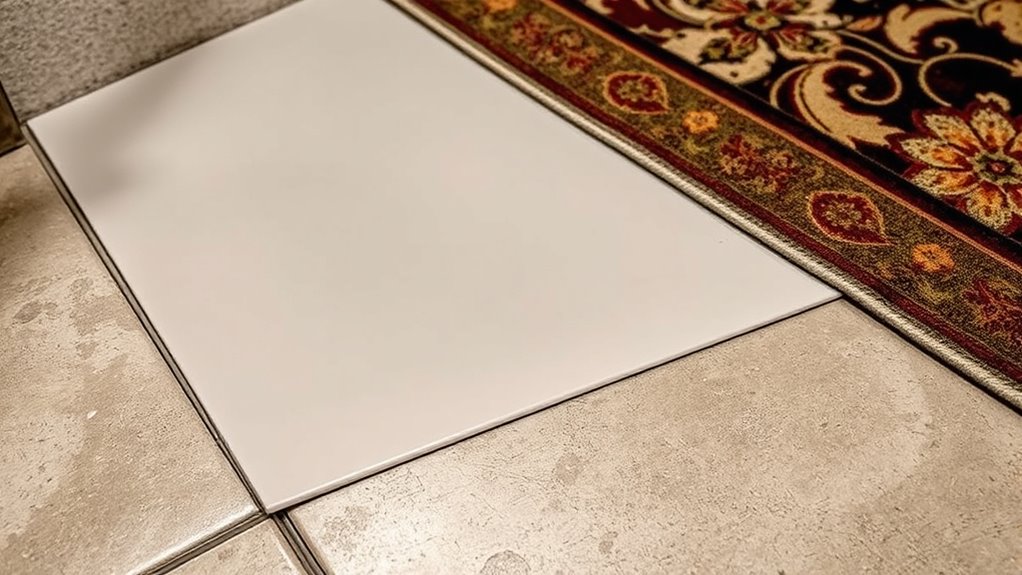
Regularly inspecting your moisture barrier is essential to guarantee it continues to protect your flooring effectively. Check for any tears, punctures, or signs of wear that could compromise its integrity. Look for areas where the barrier might have shifted or lifted, especially around seams and edges. Keep the surface clean and free of debris that could cause damage. If you notice any damage, repair it promptly with appropriate waterproof sealants or patches to prevent moisture from seeping through. It’s also helpful to periodically lift sections of the barrier to ensure it remains in good condition underneath. Regular maintenance guarantees your moisture barrier stays effective, prolongs its lifespan, and provides ongoing protection for your rugs and basement flooring.
Frequently Asked Questions
How Often Should Moisture Barriers Be Replaced in Basements?
You’re wondering how often you should replace moisture barriers in your basement. Typically, you should inspect them annually for signs of damage, wear, or moisture seepage. If you notice tears, mold, or persistent dampness, it’s time to replace the barrier. Regular checkups help prevent mold growth and protect your rugs and flooring. In most cases, with proper maintenance, moisture barriers last around 10 to 15 years before needing replacement.
Are There Eco-Friendly Moisture Barrier Options Available?
Thinking about eco-friendly moisture barriers is like choosing a plant-based diet—you get the same benefits without the environmental guilt. Yes, plenty of options are available, such as those made from recycled materials, natural rubber, or biodegradable substances. These alternatives effectively protect your basement rugs while reducing your carbon footprint. Look for products labeled as eco-friendly or sustainable, so you can shield your home and help the planet at the same time.
Can Moisture Barriers Be Installed Over Existing Rugs?
You can install moisture barriers over existing rugs, but it’s not always ideal. First, assess if your rug is in good condition and properly cleaned. Then, choose a suitable vapor barrier that can be laid beneath or over the rug without causing damage or trapping moisture. Keep in mind, the barrier’s effectiveness depends on proper installation, so follow manufacturer instructions carefully to guarantee your basement stays dry and your rug remains protected.
What Signs Indicate Moisture Barrier Failure?
When checking if a moisture barrier has failed, look for signs like persistent dampness or a musty smell in your basement. You might notice water stains or mold growth on your rugs or walls, indicating moisture seepage. Peeling or bubbling paint and increased humidity levels also suggest the barrier isn’t doing its job. Address these signs promptly to prevent further damage and maintain a dry, healthy space.
Do Moisture Barriers Affect Indoor Air Quality?
You might wonder if moisture barriers impact indoor air quality. When functioning properly, they prevent excess moisture from seeping into your home, reducing mold growth and related allergens. However, if they fail or are improperly installed, trapped moisture can lead to mold and mildew, which may release spores and volatile organic compounds (VOCs). This can negatively affect your indoor air quality, making your space less healthy and comfortable.
Conclusion
By investing in the right moisture barrier and installing it properly, you can protect your rugs from damage like a fortress guarding your treasures. Regular inspections guarantee your barrier stays strong and effective, saving you from costly replacements. Remember, neglecting this vital step could lead to water damage that’s more devastating than a hurricane in your basement. Take action now—your rugs deserve the best defense possible, so they stay beautiful and dry for years to come.
